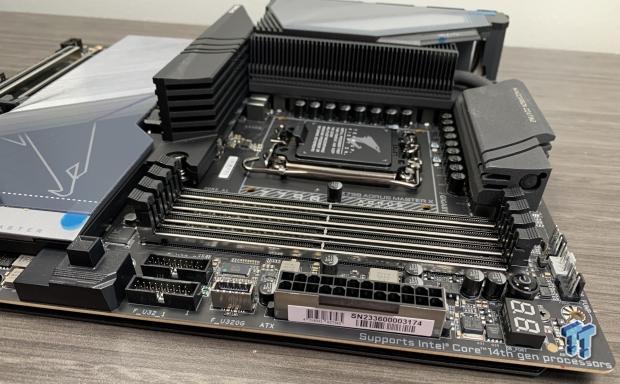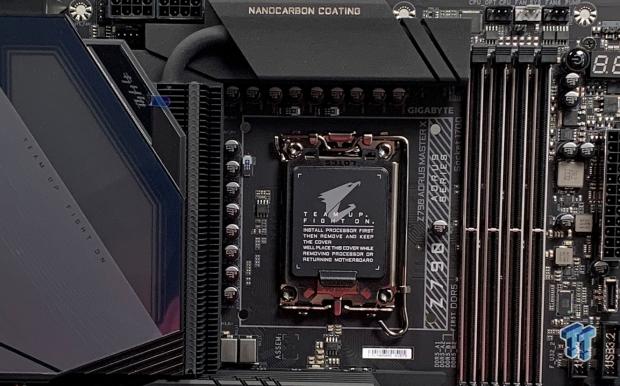
The Bottom Line
Pros
- + 20+1+2 phase VRM
- + Memory support up to DDR5 8266+
- + 10Gbe + Wi-Fi 7 networking
- + Fourteen USB 3.2 ports
- + Price considering what you get
Cons
- - None
Should you buy it?
AvoidConsiderShortlistBuyIntroduction, Specifications, and Pricing

After the MSI Godlike, Xtreme X, and ASUS's new Gen 2 offering of the Strix Z790-E Gaming Wi-Fi, the Master X from AORUS lands here in the lab as the second "mid-range" board offering. That said, AORUS has packed this motherboard with nearly identical specifications to the Xtreme X, the largest sacrifice between the two being Thunderbolt 4, making it a solid value on paper.
Specifications start and include the LGA1700 socket, offering support for 12th through 14th Gen processors, with ample power available from its 20+1+2 VRM design for users looking into overclocking any compatible CPU. DDR5 memory support includes four slots. AORUS offers specs from 4800MHz upwards to 8266MHz via overclocking.
Expansion on this offering includes three PCIe slots, the top slot offering Gen5 connectivity at full x16 width. Additional slots located at the bottom of the board connect via the chipset at Gen3 x4 and x1, respectively. Storage includes five M.2 slots, M2C being Gen5 supported pulling from the CPU alongside M2A at Gen 4. Three additional options are also available, all supporting Gen4 connectivity, M2M being the single slot to support SATA M.2. Legacy connectivity is also available via four SATA 6GB/s connections.
External connectivity is quite good, with fourteen available USB 3.2 ports on the rear I/O, the breakdown being four USB 3.2 Gen 1 and seven Gen 2. In addition, this board offers three USB-C, two of those being 20Gbps capable. LAN includes the AQC113 from Marvel, giving this motherboard 10Gbps capability, while Wi-Fi is handled by one of three available Wi-Fi chipsets between Qualcomm, Intel, and MediaTek. Our sample did have the Qualcomm chipset.
Pricing
As for pricing, the AORUS Z790 Master X comes in at $549, though it has dropped as of this writing to a much more reasonable $499.99.

Packaging, Accessories, and Overview
Packaging and Accessories

The Master X keeps with the traditional AORUS box design, featuring branding on the top left and chipset/CPU support noted on the bottom right.

We have features on the back across the top, with a diagram and specs below.

The scope of delivery includes the Wi-Fi antenna and several sets of cables.
Motherboard Overview

The Master X is an EATX solution featuring the LGA1700 socket. Four memory slots sit on the top right with a full VRM cooling around the CPU socket. This board does have a Gen5 capable NVMe heatsink installed in the top storage slot while motherboard "armor" handles cooling for the chipset and remaining M.2 slots.

On the back of the board, we also have full board armor.

The rear I/O includes SMD antenna connections at the top, followed by four USB 3.2 Gen 1 ports in blue and seven Gen 2 ports in red. We have a single DisplayPort connection for display connectivity, while two 20G USB-C are also available. The Marvel AQC113C supports a single LAN connection for 10GBps connectivity and audio at the bottom, supported by the Realtek ALC1220 chipset and ESS Sabre DAC.

The board layout includes front-panel audio and three RGB connections.

Further along the bottom, we run into dual USB 2.0 headers, two fan headers, and the front panel chassis connections.

Around the corner, we have a Thunderbolt header, two more fan headers, and four SATA connections.

At the top of the board, we have two headers for internal USB 3.2 Gen 1, a Gen 2 header, and the 24-pin power connection.

Across the top, we have three fan headers.

Tucked away near the rear I/O, we have two 8-pin connections and a fan header.
UEFI, Software and Test System
UEFI







This BIOS should look familiar to anyone who has used an AORUS motherboard in the last few generations. However, this iteration is more colorful and laid out better than past solutions. EZ-Mode provides access to hardware information and presets within GIGABYTE's "Perf Drive" technology. We also have memory and storage options along the bottom and the boot order.
Advanced mode starts with a favorites section that includes all of the most commonly visited sections of the BIOS. We then have the Tweaker menu for those wanting more advanced tuning. The settings section includes platform power configurations and an I/O port menu for users to configure everything from initial display output to settings like Re-Bar and Bifurcation support.
Motherboard Software

GIGABYTE Control Center offers software support for the motherboard with Control Center, which includes RGB Fusion to control any RGB ports or devices, like memory.

RGB Fusion options include a set of preset profiles and the ability to customize all the RGB functionality of the board.

GCC also enables fan control. Three presets are available on the left sidebar, and a custom preset for those wanting to tune their fans.
Intel Motherboard Test System
- CPU: Intel Core i7 14700K - Buy from Amazon
- GPU: AMD Radeon 7900 XTX - Buy from Amazon
- RAM: Patriot Viper Master 5 7600MHz CL36 - Buy from Amazon
- Cooler: EKWB Nucleus 240 - Buy from Amazon
- OS Storage: Crucial T700 2TB - Buy from Amazon
- Power Supply: Corsair HX1500i - Buy from Amazon
- OS: Microsoft Windows 11 Pro - Buy from Amazon
Cinebench R23 and AIDA64
Cinebench 2024
Cinebench is a long-standing render benchmark that has been heavily relied upon by both Intel and AMD to highlight their newest platforms during unveils. The benchmark has two tests: a single-core workload utilizing one thread or 1T. There is also a multi-threaded test that uses all threads or nT of a tested CPU.

The Master X matched the expected performance in Cinebench 2024 with a 133 single-core score. Multi-thread matched the Xtreme X at 2041.
CrossMark

Crossmark turned in a score of 2739 overall. Creativity continues to be the strongest workload, with Master X scoring 2956.
AIDA64 Memory
AIDA was recently updated to version 6.6, which improved performance in both AES and SHA3 workloads for Alder Lake CPUs. You will notice this performance jump in the charts below compared to earlier Intel Z690 reviews.

In AES, we picked up 263K with the Master X, matching the Xtreme X.

SHA3 came in at 7826.

Memory bandwidth is tested at DDR5 7600MHz, the Master X giving us 118K in read, 117K in write, and 114K in copy.

Memory latency for the Master X was the best we have seen at 57.6ns.
UL Procyon and 3DMark
UL Procyon Suite
The UL Procyon Office Productivity Benchmark uses Microsoft Office apps to measure PC performance for office productivity work.

UL Procyon Office gave us an overall score of 9914 for the Master X, a few points under the Xtreme X.
3DMark

CPU Profile for one and two threads gave the Master X the best numbers we have seen to date. A single thread picked up 1210 while two threads landed at 2384.

Looking at four, eight, and sixteen threads, Master X picked up 4689, 8820 and 12047, respectively. These scores here were also the highest we have seen to date as well.

Time Spy was up next. With our 14700K + 7900 XTX combo, the Master X pulled an overall score of 28752, second to the Xtreme X.

Speed Way scored 6056, once again our highest score to date with our 7900XTX.

Gaming with the Master X continued this board's solid performance in testing. We picked up 195 FPS peak at 1080p while ramping up the resolution produced, 136 FPS at 1440p, and 68 FPS at 4K.
Storage Benchmarks and Final Thoughts
3DMark Storage Benchmarks
UL's newest 3DMark SSD Gaming Test is the most comprehensive SSD gaming test ever devised. It is superior to testing against games themselves because, as a trace, it is much more consistent than variations that will occur between runs on the actual game itself. This test is the same as running the real game without the inconsistencies inherent in application testing.
In short, this is the world's best way to test an SSD's gaming prowess and accurately compare it against competing SSDs. The 3DMark SSD Gaming Test measures and scores the following:
- Loading Battlefield V from launch to the main menu.
- Loading Call of Duty Black Ops 4 from launch to the main menu.
- Loading Overwatch from launch to the main menu.
- Recording a 1080p gameplay video at 60 FPS with OBS (Open Broadcaster Software) while playing Overwatch.
- Installing The Outer Worlds from the Epic Games Launcher.
- Saving game progress in The Outer Worlds.
- Copying the Steam folder for Counter-Strike Global Offensive from an external SSD to the system drive.

Storage for the Master X offered top-tier performance with our T700, scoring 1031 MB/s bandwidth.

Testing the motherboard's Gen 5 NVMe cooling solution, we have deployed our T700 from Crucial. As seen in the chart above, we have a few boards tested now, the Master X holding our drive a touch under 40c during testing.
Final Thoughts
The Master X, like the Xtreme X, is one hell of a motherboard, packing in an absolute ton of features. This includes a solid VRM, plenty for users wanting to overclock, DDR5 memory support upwards of 8266MHZ+, superb connectivity with fourteen USB 3.2 ports on the rear I/O alone, not to mention 10Gbe and WiFi7. Against the Xtreme X, this board goes toe to toe quite easily and only lacks Thunderbolt 4 and the OLED panel.
Performance was class-leading, Master X and Xtreme X being two of the best boards we have tested; we noted these two offerings going back and forth in our charts. CB 2024, CrossMark, and AIDA64 showed nearly identical results while entering into 3DMark was where we saw Master X produce slightly higher results. Time Spy landed at 28752, Speed Way at 6056, and CPU Profile, we cracked the 12K mark with a score of 12047 with our 14700K.
Legit gaming showed amazing performance from the Master X, which was on par with all four Z790 refresh boards we have tested. 195 FPS peak at 1080p Ultra in CP2077: Phantom Liberty. Those gaming on higher resolutions like 1440p and 4K will also enjoy solid performance from the Master X; we picked up 136 FPS and 68 FPS, respectively, with the same Ultra preset.
Pricing is good on the Master X as we look at comparable motherboards in the same market segment. For instance, we recently reviewed the Z790-E Gaming Wi-Fi II from the ASUS ROG Strix lineup. Priced at $479, it offered solid connectivity with twelve USB 3.2, 2.5Gbe, and Wi-Fi 7. Master X, on the same token, offers fourteen USB 3.2, 10Gbe, and Wi-Fi 7, though it also kicks it up a notch with a more robust 20+1+2 VRM.




